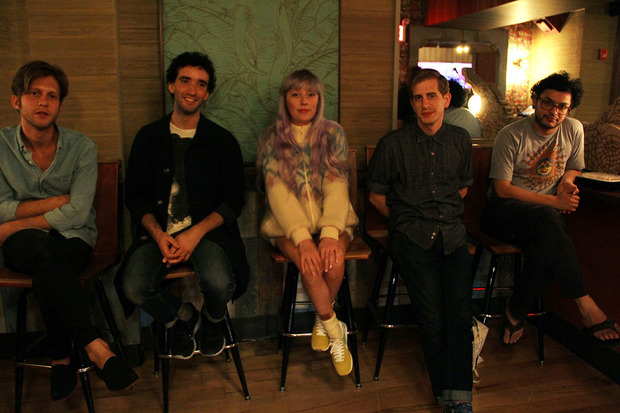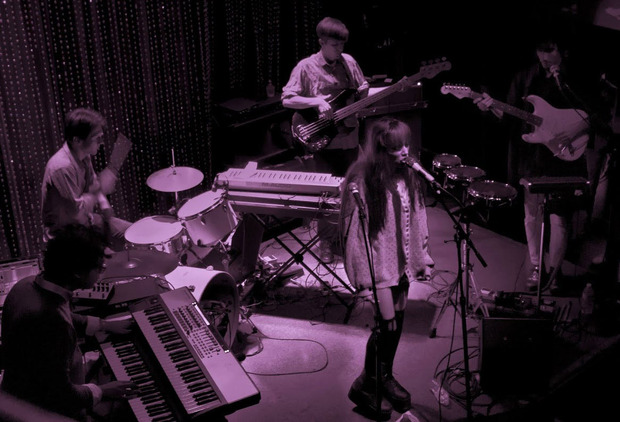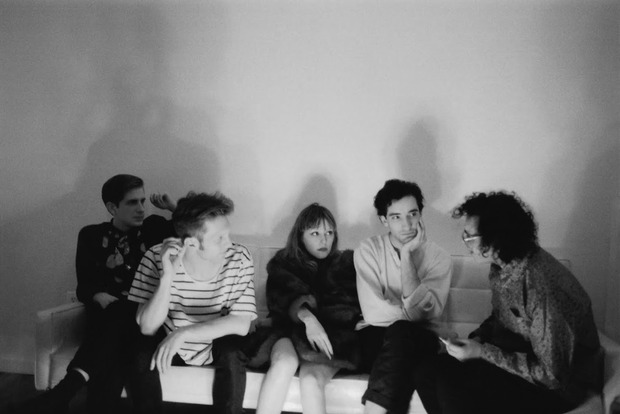Interview: Mr Twin Sister
The leaderless five-member band shares personal anecdotes and the three-year process of making their freshly dropped eponymous album


The five members of the band Mr Twin Sister, armed with a name change and their own recently established label (bidding adieu to Domino), are finally letting go of an album three years in the making. And upon listening through the eight tracks in their eponymous LP, which fittingly revolves around the themes of isolation and self-identity, the time invested shows up clearly in the intensively thought-out details. You’ve never been so seduced by a band making such strong advances. Take “In the House of Yes” for example: that subdued acid house beat, the tender piano flourishes, the processed repetitive whispers of “You’re the one” just building you up to a slow orgasmic outburst. In this album, there’s less pointing fingers at influences and genres, and more of just taking Mr Twin Sister for who they are.
The artists formerly known as Twin Sister squished into a booth at Baby’s All Right, down the street from their $275-a-month Brooklyn practice space (“very very cheap but very very basement-y and moldy”), to talk over chicken sandwiches and $3 frozen vodka grapefruit lemonades after a long day working their relatively normal day jobs. Gabel D’Amico works at Illesteva eyewear, Eric Cardona is a waiter and Bryan Ujueta is a runner, Udbhav Gupta programs and you’ll be able to see Andrea Estella in the upcoming film Veronica Mars. While Estella and Ujueta joined us later on, the harmonious group dynamic was clear from the start. There’s no single spokesperson (they all share songwriting credits, too) and after six years of playing music together, the five band members are refreshingly uncynical and rather hilarious. From Cardona reminiscing about his and his mother’s impressive Beanie Baby collection (“we had a Princess Diana bear”) to D’Amico explaining the differences between ABBA, Ace of Base and Aqua, to learning about the legal threats by an older band from the ’70s that caused their name change, we couldn’t include it all, but below is an insightful snippet from our interview.

What are the origins of this grouping—where did it all begin?
UG: We know each other from Long Island, from playing in other bands. Now we’ve known each other for a long time—I’ve known Gabe for, geez, like 10+ years at this point? We weren’t friends in high school or something—it was through playing music. And you see the same faces over and over again when you play music on Long Island.
What are your respective instruments?
UG: I play keyboard.
GD: I play bass live—everything is mixed up in recordings.
EC: Yeah, Recordings, we all have our hands in everything. I play guitar and saxophone and percussion.
UG: He sings too. Andrea sings, Bryan plays drums. On recordings, anyone does anything. Just whoever has the idea makes it on whatever instrument; it’s not set. We do a lot of the stuff at my [apartment], I’ve accumulated a lot of stuff. And Eric has some old guitars that are pretty nice.
EC: I got this weird guitar that I used a lot on this record. It’s a copy of a really old Gibson guitar, made by Univox. I bought it and then I went online and researched it after, and realized I paid way too much, it was heartbreaking. I got it at Main Drag; it was a little bit of an impulse buy. But I felt good about it; I still do—it’s just one of those things. It’s a great, big jazz guitar. That’s the one I probably used the most on the album.
GD: Dev has a lot of modular stuff that we run things through. So even when we do regular, organic-sounding instruments, often we’ll go home and signal process it through crazy stuff.

So what was the timeline of the album like?
UG: We started recording before our last one came out and that came out in… 2011.
EC: To make it more confusing, there are songs that we recorded before our last album came out that aren’t on this album, and will be out on the next one.
UG: It took us three years to make this one [laughs]. Six months was spent on artwork. There were definitely moments for me, personally, where, I don’t know if we’re going to finish this record—do we stop existing if we don’t make this? If we didn’t make this record, we would not be a band, there would nothing holding us together.
GD: We’re really good at the music part, meaning we’ve developed a language—but when it comes to anything else, our disparate tastes really get in the way of decision-making.
Do you guys have a voting system?
UG: Most bands usually have one lead voice, and we’ve figured out a way to not do that, musically. But when it comes to stuff like artwork, we get stuck in these circles of emails being “I like this!” or “I don’t like this!” We don’t know who to turn to, and there’s no one person being like “You’re fucking this up—you’re out!”
GD: We’re getting better at it though. I think our collaborative processes are getting closer to what an ideal collaborative process should be. A big part of that is letting go and putting trust in other people. I think in the future, we’re going to just hand things to each other and say “I trust you. You do this.” What happened was, we took three years to make an album and then it came time to figure out the artwork and it felt too precious to everybody to be like “Oh fuck it, let’s just let some guy do it,” or “You do it!”

Do you guys ever go to shows or concerts together?
UG: Some of us go out dancing together. And probably less now than we used to. It’s just like, going to shows is a whole thing.
I agree, there’s a lot of standing up and waiting around involved.
GD: The format of rock show is ultra-flawed. Well, think about it. Compare it to a night of seeing DJs or something like that—there are all these gaps between the performers where the next band is setting up. And usually the sound guy puts on his iPod and listening to whatever he feels like listening to. And then the next band sets up—and sometimes we’re that band—where you’re hustling to get ready and making scrunky noises on your instruments… It’s not an experience; it’s not geared towards a night of entertainment. It’s a stop-start thing. It’s constantly giving you opportunities to walk out and leave and be done with it.
Or get drunk before the next band comes on.
GD: Totally, or just show up for the band you want to see and leave immediately.
UG: When you go on tour and you’re a headlining band, you don’t necessarily
get to pick who’s playing with you, [it could be] a local band. And also maybe you’re tired from your drive and you don’t feel like telling the sound guy, “I want you to play these songs. Could you put this mix CD on?”
GD: There’s a weird gray area… Being in a venue is like being in somebody’s house. If you’re the band who’s headlining that night, you feel like you maybe have the right to control the vibe of the night. But that’s sometimes met with resistance; it depends where you’re playing, usually people are cool with it. There was a funny time when we were playing in Portland and we put on Harold Budd while we were setting up. It was this really mellow, spacious music playing—and it felt really good!
UG: And it was cold out…
GD: And there’s always a moment where you do something like that—it’s obviously intended, why would we have just done that by mistake? We were trying to offset the environment. And of course the sound guy is like, “Alright, let’s pump it up!” and changes it. So it can be hard to go against the grain of what a rock show is…
I hope your concert at Baby’s All Right turns into one big dance party.
GD: That’s what we’re hoping. It’s kind of a big celebration for us… it’s been a weird, tumultuous journey to get this thing out, so I feel pretty ready to have a good time [laughs].
So what is the composition process like with five people? Using the example of “Out of the Dark.”
UG: That one.. it started with a sample that’s not on the track anymore. We couldn’t clear it; we tried to clear it and have it official, legit, and they wanted 100% of the songwriting credit. They were taking the position that, it’s the foundation of the song. I think they didn’t really pay attention; they were just like “We’ll take this money, we want 100%.”
What happened was, we made this demo with the sample and Andrea wrote lyrics and the melody over it. We got to this point where we don’t know what to do because there’s this huge hole in the song if you take the sample out.
How did you end up filling it in?
UG: It was just us in my room, playing around. We were kind of jamming for a while. The bassline that’s there now wasn’t in the song.
GD: I think we’re pretty good about having similar pictures in our minds when something is done. We generally have a psychic connection with that stuff; when it’s done we know it, and when it needs more work we know it, and when it’s not even close we know it. I think we’ve gone as far as you can take it with the five-way democracy thing. We get stuck a lot.

What was the inspiration behind the chorus lyrics: “I am a woman, but inside I’m a man / And I want to be as gay as I can”?
AE: At the time, I wanted to dress up as this drag character for my friend’s variety show. I wanted to be a woman that is a man trying to be a woman. So I wanted to have padded hips, manly makeup and everything. I was playing with that when I was writing those lyrics—and also “Out of the Dark” is a movie I really liked from my childhood. It was like a LA slasher film; a guy in a clown mask going after call girls. It was just very trashy and I watched it as a kid and it really creeped me out. But now that I’m older, it brings me back and I really love it. It’s those vibes… and I never got to do the show.
Besides the band, do you have any other creative outlets?
AE: I do a lot. I have many creative outlets [laughs]. I paint, I sculpt, I make jewelry. I mostly just make rings. These are my really teeny rings that I’m taking out on a test run. This one is palo santo, so it smells. Sometimes I make costumes, I do art direction. I directed some stuff this summer—they’re going to be online for a children’s network that hasn’t launched yet, which is right up my alley because I love kid’s stuff. In the future, I want to design some toys [laughs].
Bryan, since you joined us last—what are your final thoughts on the new album?
BU: It felt like a long time, because it was. There’s a level of like, it’s new to so many people, but it’s not new to us at all. I’m excited that people like it, but it’s hard to be excited about the material—I’m already thinking about the next stuff. It’s like a three-year-old record to us. What excites me most is hearing our song being played in a club.
Mr Twin Sister’s eponymous album is available in digital ($8) and vinyl ($17) form released by Twin Group and Infinite Best; they’ll be celebrating their album release with two shows on 3-4 October 2014 at Baby’s All Right in Brooklyn. Mr Twin Sister will also be opening for Julian Casablancas + The Voidz in Philadelphia, DC, Charlottesville, Chattanooga, Nashville, and Atlanta during the remainder of October.
Lead image by Nara Shin, black and white image courtesy of Kimi Selfridge, performance image and music video screenshot courtesy of the artists












